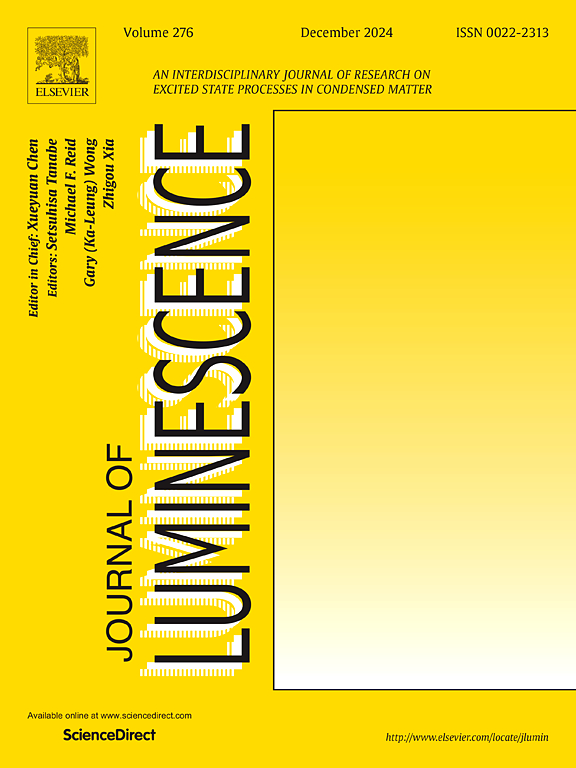用于单峰传感和发光二极管的新型绿色发光荧光粉Na4Zr2Si3O12:Eu2+
IF 3.6
3区 物理与天体物理
Q2 OPTICS
引用次数: 0
摘要
温度传感器通常使用双稀土掺杂双发射荧光粉。本文提出了一种新型的单发射绿色荧光粉Na4Zr2Si3O12: xEu2+,具有结构简单、温度灵敏度高的特点。在325 nm激发下,Na4Zr2Si3O12: xEu2+荧光粉在512 nm处呈现出宽的绿色发射峰。Na4Zr2Si3O12: xEu2+荧光粉由于在不同的环境中Eu2+占据了两种类型的Na1和Na2而呈现出不对称的发射峰。Eu2+之间的能量传递属于偶极-偶极相互作用。特别是,Na4Zr2Si3O12: xEu2+荧光粉在近紫外(NUV)激发下的单峰发射特性使其在单峰传感应用中具有独特的优势,绝对灵敏度为0.00738 K-1 (300 K- 425 K)。采用365 nm紫外芯片制备的绿色LED器件的色饱和度(Rg)可达96.2,相关色温(CCT)为6074K。在85℃和85%湿热水环境下贮存72 h后,该荧光粉具有稳定的耐侯性,在室温下发光强度分别保持在83.6%和82.1%。这些特性表明Na4Zr2Si3O12: xEu2+荧光粉在荧光照明和温度传感技术领域具有重要的应用价值。本文章由计算机程序翻译,如有差异,请以英文原文为准。
A novel green-emitting phosphor Na4Zr2Si3O12:Eu2+ for unimodal sensing and light-emitting diodes
Temperature sensors typically use dual-rare-earth-doped dual-emission phosphors. Here, an innovated single-emission green phosphor Na4Zr2Si3O12: xEu2+ is proposed, which has the characteristics of simple structure and high temperature sensitivity. Under 325 nm excitation, the Na4Zr2Si3O12: xEu2+ phosphor exhibits a broad green emission peak at 512 nm. Na4Zr2Si3O12: xEu2+ phosphors show asymmetrical emission peaks due to the fact that Eu2+ occupies two types of Na1 and Na2 in different environments. The energy transfer between Eu2+ belongs to the dipole-dipole interaction. In particular, the unimodal emission characteristics of Na4Zr2Si3O12: xEu2+ phosphor under near-ultraviolet (NUV) excitation give it a unique advantage in unimodal sensing applications, with an absolute sensitivity of 0.00738 K-1 (300 K–425 K). The color saturation (Rg) of green LED device prepared with 365 nm ultraviolet chips can reach 96.2, and the related color temperature (CCT) is 6074K. Moreover, the phosphor has stable weather resistance after 72 h of storage at 85 °C and 85 % humid heat and water environment, and the luminous intensity is maintained at 83.6 % and 82.1 % at room temperature. These characteristics indicate that Na4Zr2Si3O12: xEu2+ phosphors have important application value in the field of fluorescent lighting and temperature sensing technology.
求助全文
通过发布文献求助,成功后即可免费获取论文全文。
去求助
来源期刊

Journal of Luminescence
物理-光学
CiteScore
6.70
自引率
13.90%
发文量
850
审稿时长
3.8 months
期刊介绍:
The purpose of the Journal of Luminescence is to provide a means of communication between scientists in different disciplines who share a common interest in the electronic excited states of molecular, ionic and covalent systems, whether crystalline, amorphous, or liquid.
We invite original papers and reviews on such subjects as: exciton and polariton dynamics, dynamics of localized excited states, energy and charge transport in ordered and disordered systems, radiative and non-radiative recombination, relaxation processes, vibronic interactions in electronic excited states, photochemistry in condensed systems, excited state resonance, double resonance, spin dynamics, selective excitation spectroscopy, hole burning, coherent processes in excited states, (e.g. coherent optical transients, photon echoes, transient gratings), multiphoton processes, optical bistability, photochromism, and new techniques for the study of excited states. This list is not intended to be exhaustive. Papers in the traditional areas of optical spectroscopy (absorption, MCD, luminescence, Raman scattering) are welcome. Papers on applications (phosphors, scintillators, electro- and cathodo-luminescence, radiography, bioimaging, solar energy, energy conversion, etc.) are also welcome if they present results of scientific, rather than only technological interest. However, papers containing purely theoretical results, not related to phenomena in the excited states, as well as papers using luminescence spectroscopy to perform routine analytical chemistry or biochemistry procedures, are outside the scope of the journal. Some exceptions will be possible at the discretion of the editors.
 求助内容:
求助内容: 应助结果提醒方式:
应助结果提醒方式:


